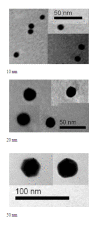Rheological and dielectric properties of different gold nanoparticle sizes
- PMID: 22078458
- PMCID: PMC3231822
- DOI: 10.1186/1476-511X-10-208
Rheological and dielectric properties of different gold nanoparticle sizes
Abstract
Background: Gold nanoparticles (GNPs) have found themselves useful for diagnostic, drug delivery and biomedicine applications, but one of the important concerns is about their safety in clinical applications. Nanoparticle size has been shown to be an extremely important parameter affecting the nanoparticle uptake and cellular internalization. The rheological properties assume to be very important as it affects the pressure drop and hence the pumping power when nano-fluids are circulated in a closed loop. The rheological and dielectric properties have not been documented and identified before. The aim of the present study was to investigate the rheology and the dielectric properties of different GNPs sizes in aqueous solution.
Methods: 10, 20 and 50 nm GNPs (Product MKN-Au, CANADA) was used in this study. The rheological parameters were viscosity, torque, shear stress, shear rate, plastic viscosity, yield stress, consistency index, and activation energy. These rheological parameters were measured using Brookfield LVDV-III Programmable rheometer supplied with temperature bath and controlled by a computer.
Results: The shear stress and shear rate of GNPs have shown a linear relationship and GNPs exhibited Newtonian behaviour. The GNPs with larger particle size (50 nm) exhibited more viscosity than those with smaller particle sizes (10 and 20 nm). Viscosity decreased with increasing the temperature for all the examined GNP sizes. The flow behaviour index (n) values were nearly ≤ 1 for all examined GNP sizes. Dielectric data indicated that the GNPs have strong dielectric dispersion in the frequency range of 20-100 kHz. The conductivity and relaxation time decreased with increasing the GNP size.
Conclusions: This study indicates that the GNP size has considerable influence on the viscosity of GNPs. The strong dielectric dispersion was GNP size dependent. The decrease in relaxation time might be attributed to increase in the localized charges distribution within the medium confirmed by the conductivity data. This study suggests that further experiments are required to be done after the administration of GNPs through different routes in rats in vivo.
Figures









References
-
- Brust M, Bethell D, Kiely CJ, Schiffrin DJ. Self-assembled gold nanoparticle thin films with non-metallic optical and electronic properties. Langmuir. 1998;14(19):5425–5429. doi: 10.1021/la980557g. - DOI
-
- Li H, Jiang L. Polymer light-emitting diodes with spin-coated poly.(3,4-ethylenedioxythiophene)- polystyrenesulfonate as transparent anode. Prog Chem. 1997;9:397.
-
- Schmid G. Large clusters and colloids. Metals in the embryonic state. Chem Rev. 1992;92:1709. doi: 10.1021/cr00016a002. - DOI
-
- Brust M, Fink J, Bethell D, Schiffrin DJ, Kiely C. Synthesis and Reactions of Functionalised Gold Nanoparticles. J Chem Soc, Chem Comm. 1995. pp. 1655–1656.
-
- Collier CP, Saykally RJ, Shiang JJ, Henrichs SE, Heath JR. Reversible Tuning of Silver Quantum Dot Monolayers Through the Metal-Insulator Transition. Science. 1997;277:1978. doi: 10.1126/science.277.5334.1978. - DOI
Publication types
MeSH terms
Substances
LinkOut - more resources
Full Text Sources

